Relevance. Nowadays, data mining and information retrieval to determine the ability of young hockey players to score goals are quite rare. It is believed that the high ability to react quickly allows young hockey players to be more successful in their activities.
The purpose of this work is to analyze information on the psychological, psychophysiological and physiological development of 12-14 year old adolescents, as well as to determine the link between high rates in reaction speed and the ability of hockey players to score goals.
Hypothesis. The study’s supposed to provide coaching staff and the other children and youth hockey workers with the data showing the importance of the characteristics of psychophysiological functions in relation to the effectiveness of the hockey forwards at the stage of sports specialization with an individual and group comparison of the most and less effective players.
Theoretical basis and methodology. To work with athletes in adolescence, coaches should use special pedagogical techniques that support the interest and attention of the child. They should develop the interest and also form the motivation to achieve high technology, the desire to win, the desire to be a highly professional athlete. The use of emotional factors by the coach, as well as the motivational component, will form the adolescent's desire to assert his place among his peers, teammates (Kabardov, 2013).
Social motivation, being properly formed and at the same time taking the adolescent's self-esteem into account, is very important for a child in adolescence (Ilyin, 2000).
Only in the very final stage of adolescence there is a stable interaction of all links of the endocrine system, the destabilizing effect of puberty on the brain stops. So the functions of attention and motivational activity can be realized by the adolescent more freely (Gorbunov, 2006).
It is difficult to predict the behavior of a teenager at the psychoemotional level. The emotional background of a teenager is extremely unstable, the behavior is uncontrollable. The teenager's working capacity and adaptive capabilities, which would take place in the process of both training and educational activities of a teenager, decrease (Mayorov, 1968).
The second signaling system develops rapidly during the adolescence. It is becoming increasingly important in the formation of new conditioned reflexes and skills. The concentration of the processes of excitation and inhibition increases. The inhibitory function of the cerebral cortex is becoming more and more significant, and its control over emotional reactions increases (Luria, 2018). The adolescent is already capable of conscious inhibition of one or another semi-voluntary action (the development of the process of internal inhibition continues). There is a certain decline in the stability of attention (which passes by the age of 14), while the efficiency of thinking continues to increase, reaching its peak by the age of 13. After it (at about 14 years old) for some time it remains approximately at the same level. The ability to process information, to make quick decisions improves, the efficiency of tactical thinking increases, and the time for solving tactical problems is reliably reduced (Ashmarin, 1978).
The age of 13-14 years is considered as a sensitive period for the development of such qualities as the maximum frequency of movements, the speed of sensorimotor reactions - both simple and complex (to the greatest extent - the choice reactions), the accuracy of musculo-motor differentiations, the speed of switching attention. However, when passing psychomotor tests, the percentage of erroneous reactions increases. It indicates a general increase in the excitability of the central nervous system. When responding to verbal stimuli, the response time is lengthened (Luchinin, 2004; Ehrlich, Lychagina, Yumaguen and Gustomyasov, 2005).
Adolescence is a period of continuing improvement of motor abilities, great opportunities for the development of motor qualities. Individual coordination abilities of the secondary school children improve at a fairly high rate (in particular, in throws for accuracy). The second sensitive period of the development of the ability to restructure motor actions begins. It should be noted that motor memory temporarily ceases to develop progressively (at the same time, its deterioration does not occur). Until the age of 13-14, the functions of the motor analyzer reach a high level of development, the accuracy of movements develops (later the development slows down). The most intensive increase in accuracy is characteristic of movements performed with both hands. When correcting movements during their execution, the role of muscle sensitivity becomes predominant (Vaytsekhovsky, 1971).
Low rates are observed in the development of flexibility and speed of movements. The peak of this process is observed at 10-13 years; a slowdown, sometimes even a stop - at the age of 13-14. Its maximum the speed of a single movement often reaches by the age of 13-14.
The adolescence (from 11-12 to 15-17 years old) period has particular importance for coaches. At this time, the balance of nervous processes is disturbed, excitement becomes more powerful, the increase in the mobility of nervous processes slows down, the differentiation of conditioned stimuli significantly worsens. The activity of the cortex and the second signaling system are weakened. All functional changes lead to mental imbalance and conflict in the adolescent (Knight, Harwood and Gould, 2017).
Researches during the adolescence period help to determine that at this age it is very important not to overload a not yet strengthened body with heavy loads. The assessment of fatigue is the greatest matter of concern for the analysis of literary sources. Since fatigue is a borderline issue between physiology and psychophysiology, its definition largely depends on the chosen research methods. In the study of psychophysiological functions, it is important to take into account the fact that the passage of basic diagnostics to determine the speed of simple and complex reactions to a state of fatigue will not allow to evaluate the effectively important indicators for our research.
Physiological and psychophysiological methods for the study of fatigue are the following:
1. Measurement of fatigue of the central nervous system, consideration of the nervous regulation of functions in the body.
2. Also, in addition to considering the fatigue of the central nervous system, considering the fatigue of other organs as the basis of fatigue – determination of the ratio of changes that characterize fatigue with the changes that usually occur in the body during work (Goswami, 2014).
We must consider the matter in such a way that those changes in various organs and systems that arise in them during work, with a certain combination of them and a certain degree of these changes, create a qualitatively different state of the organism. It determines both a change in its working capacity and its other reaction to repeated workload. Thus, any fatigue is associated in its nature with those changes that occur in the body during work, but these changes do not always lead to fatigue. It occurs only with a certain combination and degree of these changes, as a result of which the body's response to a workload will change. The picture of fatigue is different depending on the change in the functions of which organs led to fatigue (Muller, 2001; Dennis, 2018; Dosil, 2005).
Fatigue causes stress. In addition to the load, there are such main factors of fatigue as:
load and its dynamic or statistical nature;
factor of temporal distribution of the load or its intensity;
constant nature of the load;
rhythm of the load.
Regular statistical load contributes to greater fatigue than dynamic load. Statistical load is characterized by a clear expression of fatigue.
The intensity of the load regulates the degree of fatigue: with an increase in the load, fatigue will occur much earlier. However if the intensity of the load is reduced, it is impossible to talk about a long period of non-fatigue. The time of onset of fatigue will not change. Although in the latter case, a noticeable decrease in labor productivity stands out.
Fatigue is a component that many coaches refer to when a young ice hockey player does not achieve scoring chances. Against the background of fatigue, such indicators as the speed of a simple visual-motor reaction, the discrimination reaction and the choice reaction are reduced. Is there an interdependence between the realization of scoring chances and high indicators of psychophysiological functions, if the accuracy of the shots deteriorates against the background of fatigue (Pocock, C. Richards and
D. Richards, 2017)?
Next, consider the definitions:
simple visual-motor reaction;
discrimination reaction;
choice reaction.
Simple visual motor reaction - the speed of response with a known simple single suddenly appearing, but known in advance movement (Volkov, 1981).
The discrimination reaction is the process by which two or more stimuli that initially elicited equivalent responses begin to differ functionally as a result of differentiated reinforcement of responses to those stimuli. In this aspect, the conditioned reaction prevails over the unconditional, and the general situation is presented as an opportunity to choose an alternative. So, a teenager must make his individual choice from several options (Volkov, 1981).
We took the definition of the “choice reaction” from the book of S.M. Voitsekhovsky, who understood the choice reaction as a complex reaction, which depends on such factors as:
latent time of a simple reaction of an athlete;
a stock of tactical techniques of an athlete, which were developed during the training process;
a stock of tactical actions of a hockey player, which were developed during the training process;
the ability of a hockey player to instantly choose from tactical actions and techniques the one that will be most beneficial in this aspect (game situation) (Vaytsekhovsky, 1971).
The main goal of the study is the ratio of testing indicators and the effectiveness of forwards in hockey (goals), identifying the presence or absence of patterns.
Materials and methods of research: testing was carried out using psychophysiological and psychological diagnostics with the help of special equipment. A total of 80 young hockey players, aged 12 to 14, participated in the study. For a more convenient perception of the information, we divided the information into two tables based on the results of the 40 forwards passed the test (tables 1 and 2).
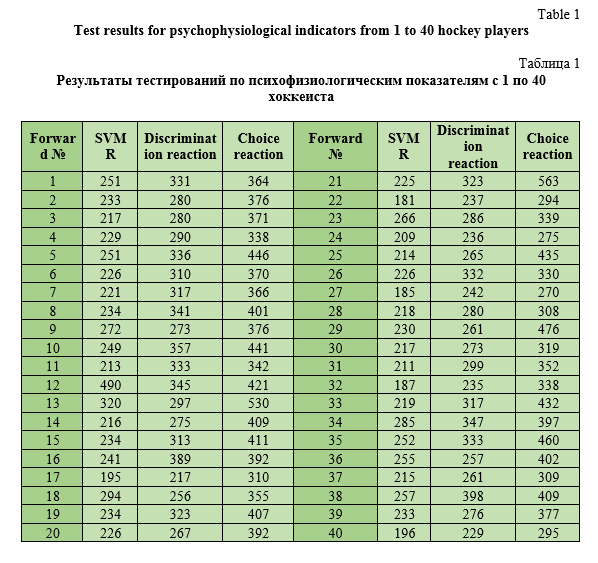
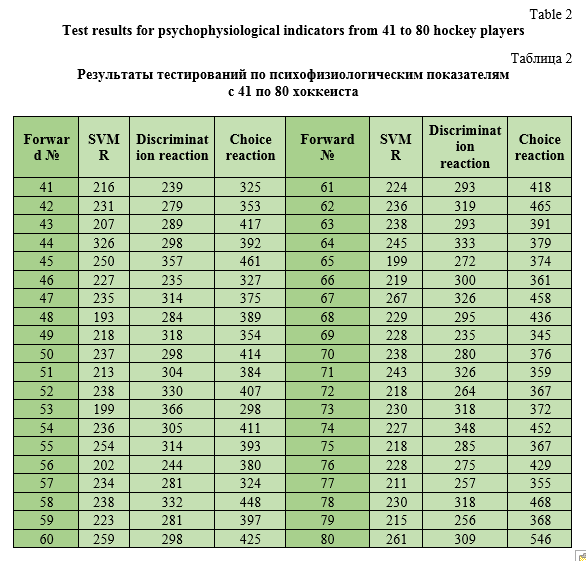
According to the survey results, there are no ailments found in young hockey players. Testing took place against the background of functional readiness during the competitive season.
Research results and discussion. In assessing and understanding how a simple visual-motor reaction, discrimination reaction and choice reaction are important for the effectiveness of hockey forwards, we conditionally set points for average performance (goals) based on the studied young hockey players:
from 0.00 to 0.17 = 1 point (80-61 place in the rating of abandoned pucks);
from 0.18 to 0.33 = 2 points (60-41 place in the rating of goals scored);
from 0.34 to 0.52 = 3 points (40-21 place in the rating of goals scored);
from 0.54 to 1.38 = 4 points (20-1 place in the rating of goals scored);
from 0.00 to 0.16 = 1 point (80-61 place in the rating of assists).
We propose the following assessment method in our study. During the studying of 80 hockey forwards, we divided the subjects into 4 groups of 20 people each (tables 3, 4 and 5). Further, according to the indicators, the assessment score will be calculated. The calculation will be carried out in the following way:
formation of a table from the maximum to the minimum indicator in terms of indicators;
the summation of points according to the proposed evaluation criterion;
description of brief conclusions according to the tables.
This method of assessment will help us to objectively assess the impact of simple visual-motor reaction, discrimination reaction and choice reaction on the ability of forwards to make effective shots in hockey.
Results.
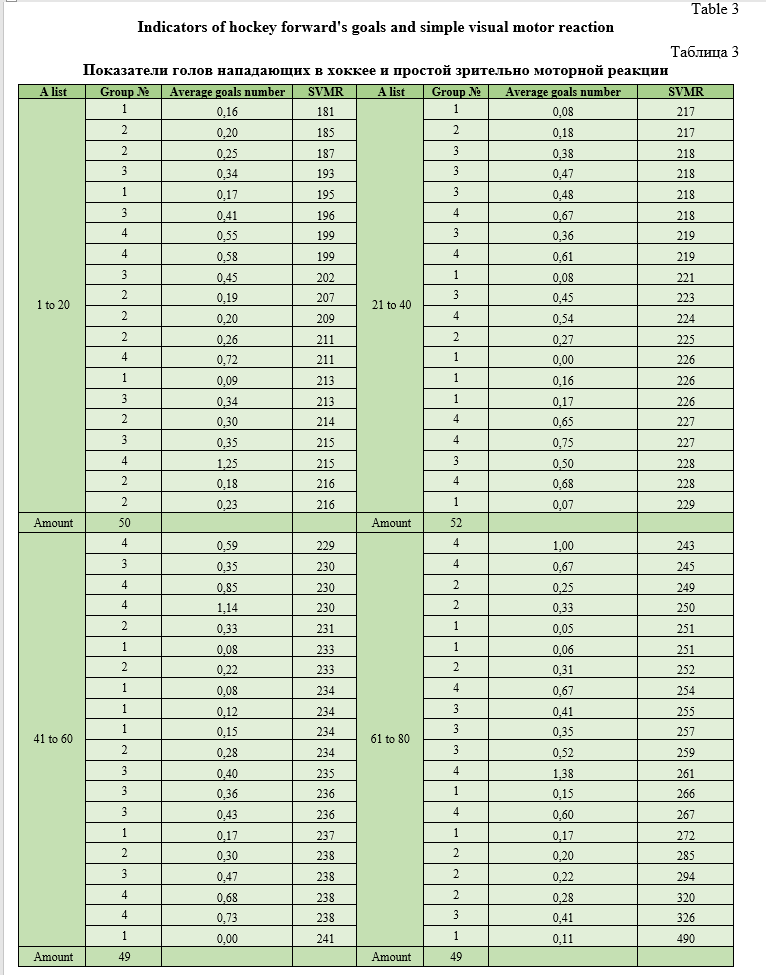
As a part of the comparison of goals scored by hockey forwards and the speed of a simple visual-motor reaction, it can be mentioned that no correlations have been identified.
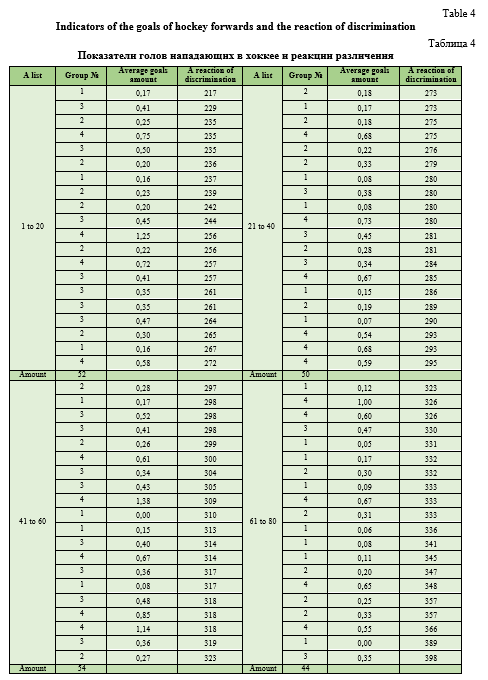
As part of the comparison of goals scored by forwards in hockey and reaction speed of discrimination, it can be said that forwards from 61 to 80 points in the rating list received a total of 44 points in comparison with other players.
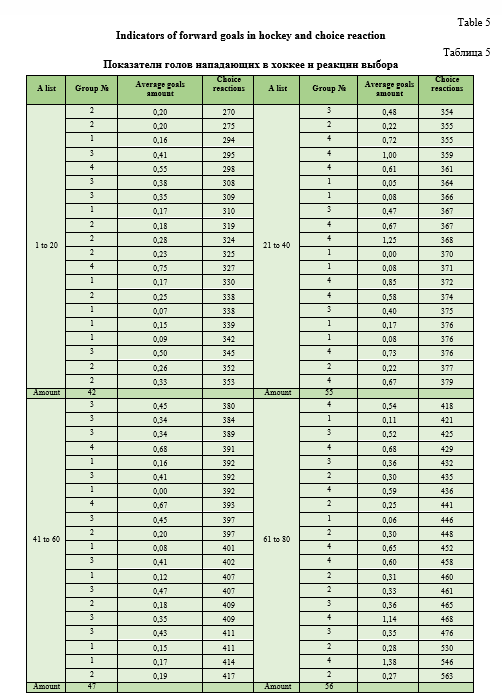
As a part of the comparison of goals scored by hockey forwards and the speed of choice reaction, it can be said that the lowest score is in the forwards from 1 to 20 points.
Further we will consider the next method in more details. Using this method, it is possible to define the existence of statistic difference in psychophysiological qualities between forwards having the average amount of scored goals >=1,00 and forwards having the average amount of scored goals <=0,10 (table 6).

If you pay attention to the players with the biggest amount of goals scored to the opponent gate, you can see that their discrimination reaction speed is better developed. Forwards with the amount of goals scored to the opponent gate <=0,10 have the advantages in all the other aspects.
Conclusion. In this study important psychophysiological characteristics of the investigated and described functions were considered in order to select and determine the roles of hockey players at the stage of sports specialization. In the conditions of high competition between young hockey players in the leading hockey schools, when athletes move from the stage of sports specialization to the stage of improving sportsmanship, there is a need for an additional assessment of the abilities of hockey players. We tried to consider the issue of selection from a psychophysiological point of view.
According to the results of the study, it can be noted that, in general, the speed of a simple visual-motor reaction, a reaction of discrimination and a reaction of choice is not associated with the ability of forwards to score goals. Having carried out this study, we can note that the measurements made on special equipment did not show actual indicators except an assessment of the speed of various types of reactions. The use of the obtained data in practice is unlikely.























Reference lists